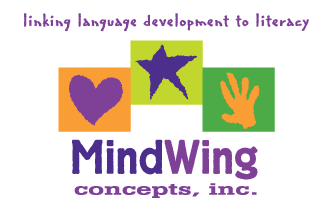Secure Checkout + FREE SHIPPING (U.S. Orders over $60)
Menu
-
- Home
-
About Us
-
The Approach
-
Linking Language & Literacy
-
Professional Learning
-
Learning Resources
-
SHOP
-
Blog
-
- About MindWing
- Our People
- Contact Us
- Your Account
- Login
-
United States (USD $)

Secure Checkout + FREE SHIPPING (U.S. Orders over $60)

Adobe Voice gives “Voice” to Narrative or Expository Language
October 13, 2015
 It’s Technology Tuesday, and this month we will cover a simple, free tool to practice combining visuals and oral narration to produce an engaging video! A main goal of using MindWing’s Story Grammar Marker® and ThemeMaker® tools is to provide structure for oral discourse. Narrative or expository maps provide a “plan” for the elements of discourse, along with key words to help students connect their thoughts when formulating a story or explanation. In this way, a culminating activity of using any language map can involve asking students to “connect the dots” in formulating a complete story or using expository language. Adobe Voice, a free, easy-to-use app, provides a fast and motivating way to do this!...
It’s Technology Tuesday, and this month we will cover a simple, free tool to practice combining visuals and oral narration to produce an engaging video! A main goal of using MindWing’s Story Grammar Marker® and ThemeMaker® tools is to provide structure for oral discourse. Narrative or expository maps provide a “plan” for the elements of discourse, along with key words to help students connect their thoughts when formulating a story or explanation. In this way, a culminating activity of using any language map can involve asking students to “connect the dots” in formulating a complete story or using expository language. Adobe Voice, a free, easy-to-use app, provides a fast and motivating way to do this!...

Create Visual “Explanimations” to go with your Expository Lessons
September 15, 2015

Bring EPIC Contexts to Your Use of Story Grammar Marker®
August 18, 2015

As they are contextual tools, it’s important to consider context when developing narrative and expository language with SGM® and Thememaker®, respectively. Picture books naturally make terrific contexts to work on narrative at a range of developmental stages and teach identification and use of expository text structures. This summer, while you are away from your school libraries, you can check out the gold mine of contexts that is the EPIC! Unlimited Books for Kids app (free for iPad). When you launch the app, sign up for an educator account (also free) and you will have access to an amazing library of picture and chapter books from leading publishers such as Harper Collins, National Geographic and MacMillan. As the app claims to be, “it’s like a Netflix for children’s books!”...
Technology Tuesday: Vocabulary, Summer Programming, and Story Grammar Marker®!
June 09, 2015 2 Comments
 Some years ago as an SLP in the elementary school setting, I was informed by a colleague of Isabel Beck’s revolutionary approach to targeting vocabulary. In the book Bringing Words to Life: Robust Vocabulary Development, co-written with Margaret McKeown and Linda Kucan, the authors describe a methodology for building vocabulary revolving around key principles...
Some years ago as an SLP in the elementary school setting, I was informed by a colleague of Isabel Beck’s revolutionary approach to targeting vocabulary. In the book Bringing Words to Life: Robust Vocabulary Development, co-written with Margaret McKeown and Linda Kucan, the authors describe a methodology for building vocabulary revolving around key principles...
Getting the “Story” of a Situation
May 12, 2015
In working with SLPs, teachers, other professionals and graduate students around the myriad ways I find Story Grammar Marker® useful in intervention, I often emphasize how narrative is at the crux of language functioning and social cognition. This post will explore this idea with an eye toward the concept of situational awareness, an area we can look at as critical for many of our students with social learning challenges--an appropriate topic for May as it is Better Speech and Hearing Month!
In their article, Social Learning and Social Functioning: Social Thinking's Cascade of Social Functioning, Michelle Garcia Winner and Pamela Crooke describe how awareness of situations serves as the foundation of interactions. Social functioning can then be considered a "cascade" of additional skills such as self-awareness within a situation (and understanding of one's own possible role in the ongoing situation) and abstracting and interpreting the ongoing language and actions of others.
Complete and Share SGM® Story Maps (Paperless!) with Google Drive
March 16, 2015
 The MindWing Narrative and Expository Maps are to me an invaluable part of the visual language tools within the Braidy the StoryBraid®, Story Grammar Marker®, and ThemeMaker® programs. Of course the SGM iPad App gives you one option to work with the icons in these programs digitally while scaffolding language development--but it’s not the only way!
The MindWing Narrative and Expository Maps are to me an invaluable part of the visual language tools within the Braidy the StoryBraid®, Story Grammar Marker®, and ThemeMaker® programs. Of course the SGM iPad App gives you one option to work with the icons in these programs digitally while scaffolding language development--but it’s not the only way!
Google Apps for Education is a resource that is now implemented in many public school districts, allowing for digital creation, storage, sharing, and collaboration on word processing and other types of documents. The power of Google Apps (a.k.a. “Drive” or “Docs” — they all pretty much mean the same thing) is that it gives you access to your files from any computer or device, and allows you to share important information between key staff members without handing off any paper! If your district has not implemented Google’s tools, you can also access all of them for free with a Google account (i.e. if you have a Gmail, you can just navigate to your Google Drive). Click on the “matrix” of squares in any Google account to navigate between apps, including Google Drive...
